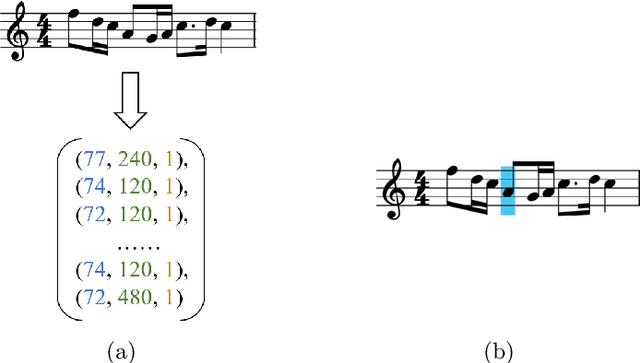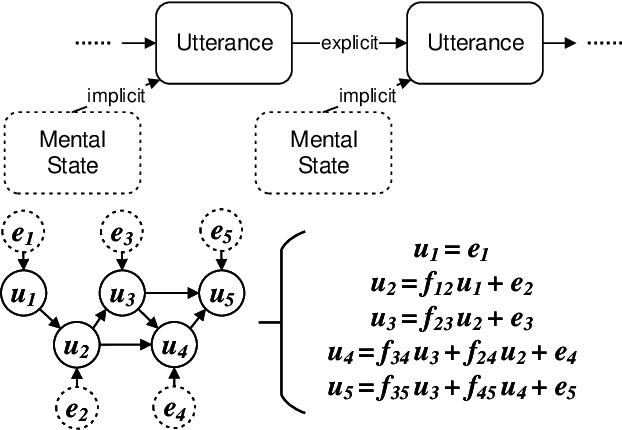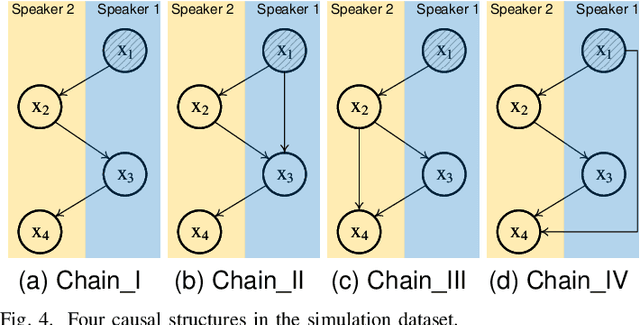Jing Luo
Exploring Classical Piano Performance Generation with Expressive Music Variational AutoEncoder
Jul 02, 2025Abstract:The creativity of classical music arises not only from composers who craft the musical sheets but also from performers who interpret the static notations with expressive nuances. This paper addresses the challenge of generating classical piano performances from scratch, aiming to emulate the dual roles of composer and pianist in the creative process. We introduce the Expressive Compound Word (ECP) representation, which effectively captures both the metrical structure and expressive nuances of classical performances. Building on this, we propose the Expressive Music Variational AutoEncoder (XMVAE), a model featuring two branches: a Vector Quantized Variational AutoEncoder (VQ-VAE) branch that generates score-related content, representing the Composer, and a vanilla VAE branch that produces expressive details, fulfilling the role of Pianist. These branches are jointly trained with similar Seq2Seq architectures, leveraging a multiscale encoder to capture beat-level contextual information and an orthogonal Transformer decoder for efficient compound tokens decoding. Both objective and subjective evaluations demonstrate that XMVAE generates classical performances with superior musical quality compared to state-of-the-art models. Furthermore, pretraining the Composer branch on extra musical score datasets contribute to a significant performance gain.
Uncertainty-Aware Machine-Learning Framework for Predicting Dislocation Plasticity and Stress-Strain Response in FCC Alloys
Jun 25, 2025Abstract:Machine learning has significantly advanced the understanding and application of structural materials, with an increasing emphasis on integrating existing data and quantifying uncertainties in predictive modeling. This study presents a comprehensive methodology utilizing a mixed density network (MDN) model, trained on extensive experimental data from literature. This approach uniquely predicts the distribution of dislocation density, inferred as a latent variable, and the resulting stress distribution at the grain level. The incorporation of statistical parameters of those predicted distributions into a dislocation-mediated plasticity model allows for accurate stress-strain predictions with explicit uncertainty quantification. This strategy not only improves the accuracy and reliability of mechanical property predictions but also plays a vital role in optimizing alloy design, thereby facilitating the development of new materials in a rapidly evolving industry.
Small Tunes Transformer: Exploring Macro & Micro-Level Hierarchies for Skeleton-Conditioned Melody Generation
Oct 11, 2024



Abstract:Recently, symbolic music generation has become a focus of numerous deep learning research. Structure as an important part of music, contributes to improving the quality of music, and an increasing number of works start to study the hierarchical structure. In this study, we delve into the multi-level structures within music from macro-level and micro-level hierarchies. At the macro-level hierarchy, we conduct phrase segmentation algorithm to explore how phrases influence the overall development of music, and at the micro-level hierarchy, we design skeleton notes extraction strategy to explore how skeleton notes within each phrase guide the melody generation. Furthermore, we propose a novel Phrase-level Cross-Attention mechanism to capture the intrinsic relationship between macro-level hierarchy and micro-level hierarchy. Moreover, in response to the current lack of research on Chinese-style music, we construct our Small Tunes Dataset: a substantial collection of MIDI files comprising 10088 Small Tunes, a category of traditional Chinese Folk Songs. This dataset serves as the focus of our study. We generate Small Tunes songs utilizing the extracted skeleton notes as conditions, and experiment results indicate that our proposed model, Small Tunes Transformer, outperforms other state-of-the-art models. Besides, we design three novel objective evaluation metrics to evaluate music from both rhythm and melody dimensions.
PersonaMath: Enhancing Math Reasoning through Persona-Driven Data Augmentation
Oct 02, 2024



Abstract:While closed-source Large Language Models (LLMs) demonstrate strong mathematical problem-solving abilities, open-source models continue to struggle with such tasks. To bridge this gap, we propose a data augmentation approach and introduce PersonaMathQA, a dataset derived from MATH and GSM8K, on which we train the PersonaMath models. Our approach consists of two stages: the first stage is learning from Persona Diversification, and the second stage is learning from Reflection. In the first stage, we regenerate detailed chain-of-thought (CoT) solutions as instructions using a closed-source LLM and introduce a novel persona-driven data augmentation technique to enhance the dataset's quantity and diversity. In the second stage, we incorporate reflection to fully leverage more challenging and valuable questions. Evaluation of our PersonaMath models on MATH and GSM8K reveals that the PersonaMath-7B model (based on LLaMA-2-7B) achieves an accuracy of 24.2% on MATH and 68.7% on GSM8K, surpassing all baseline methods and achieving state-of-the-art performance. Notably, our dataset contains only 70.3K data points-merely 17.8% of MetaMathQA and 27% of MathInstruct-yet our model outperforms these baselines, demonstrating the high quality and diversity of our dataset, which enables more efficient model training. We open-source the PersonaMathQA dataset, PersonaMath models, and our code for public usage.
Investigating the Impact of Model Complexity in Large Language Models
Oct 01, 2024Abstract:Large Language Models (LLMs) based on the pre-trained fine-tuning paradigm have become pivotal in solving natural language processing tasks, consistently achieving state-of-the-art performance. Nevertheless, the theoretical understanding of how model complexity influences fine-tuning performance remains challenging and has not been well explored yet. In this paper, we focus on autoregressive LLMs and propose to employ Hidden Markov Models (HMMs) to model them. Based on the HMM modeling, we investigate the relationship between model complexity and the generalization capability in downstream tasks. Specifically, we consider a popular tuning paradigm for downstream tasks, head tuning, where all pre-trained parameters are frozen and only individual heads are trained atop pre-trained LLMs. Our theoretical analysis reveals that the risk initially increases and then decreases with rising model complexity, showcasing a "double descent" phenomenon. In this case, the initial "descent" is degenerate, signifying that the "sweet spot" where bias and variance are balanced occurs when the model size is zero. Obtaining the presented in this study conclusion confronts several challenges, primarily revolving around effectively modeling autoregressive LLMs and downstream tasks, as well as conducting a comprehensive risk analysis for multivariate regression. Our research is substantiated by experiments conducted on data generated from HMMs, which provided empirical support and alignment with our theoretical insights.
Mirror contrastive loss based sliding window transformer for subject-independent motor imagery based EEG signal recognition
Aug 29, 2024



Abstract:While deep learning models have been extensively utilized in motor imagery based EEG signal recognition, they often operate as black boxes. Motivated by neurological findings indicating that the mental imagery of left or right-hand movement induces event-related desynchronization (ERD) in the contralateral sensorimotor area of the brain, we propose a Mirror Contrastive Loss based Sliding Window Transformer (MCL-SWT) to enhance subject-independent motor imagery-based EEG signal recognition. Specifically, our proposed mirror contrastive loss enhances sensitivity to the spatial location of ERD by contrasting the original EEG signals with their mirror counterparts-mirror EEG signals generated by interchanging the channels of the left and right hemispheres of the EEG signals. Moreover, we introduce a temporal sliding window transformer that computes self-attention scores from high temporal resolution features, thereby improving model performance with manageable computational complexity. We evaluate the performance of MCL-SWT on subject-independent motor imagery EEG signal recognition tasks, and our experimental results demonstrate that MCL-SWT achieved accuracies of 66.48% and 75.62%, surpassing the state-of-the-art (SOTA) model by 2.82% and 2.17%, respectively. Furthermore, ablation experiments confirm the effectiveness of the proposed mirror contrastive loss. A code demo of MCL-SWT is available at https://github.com/roniusLuo/MCL_SWT.
BandControlNet: Parallel Transformers-based Steerable Popular Music Generation with Fine-Grained Spatiotemporal Features
Jul 15, 2024Abstract:Controllable music generation promotes the interaction between humans and composition systems by projecting the users' intent on their desired music. The challenge of introducing controllability is an increasingly important issue in the symbolic music generation field. When building controllable generative popular multi-instrument music systems, two main challenges typically present themselves, namely weak controllability and poor music quality. To address these issues, we first propose spatiotemporal features as powerful and fine-grained controls to enhance the controllability of the generative model. In addition, an efficient music representation called REMI_Track is designed to convert multitrack music into multiple parallel music sequences and shorten the sequence length of each track with Byte Pair Encoding (BPE) techniques. Subsequently, we release BandControlNet, a conditional model based on parallel Transformers, to tackle the multiple music sequences and generate high-quality music samples that are conditioned to the given spatiotemporal control features. More concretely, the two specially designed modules of BandControlNet, namely structure-enhanced self-attention (SE-SA) and Cross-Track Transformer (CTT), are utilized to strengthen the resulting musical structure and inter-track harmony modeling respectively. Experimental results tested on two popular music datasets of different lengths demonstrate that the proposed BandControlNet outperforms other conditional music generation models on most objective metrics in terms of fidelity and inference speed and shows great robustness in generating long music samples. The subjective evaluations show BandControlNet trained on short datasets can generate music with comparable quality to state-of-the-art models, while outperforming them significantly using longer datasets.
API Is Enough: Conformal Prediction for Large Language Models Without Logit-Access
Mar 02, 2024



Abstract:This study aims to address the pervasive challenge of quantifying uncertainty in large language models (LLMs) without logit-access. Conformal Prediction (CP), known for its model-agnostic and distribution-free features, is a desired approach for various LLMs and data distributions. However, existing CP methods for LLMs typically assume access to the logits, which are unavailable for some API-only LLMs. In addition, logits are known to be miscalibrated, potentially leading to degraded CP performance. To tackle these challenges, we introduce a novel CP method that (1) is tailored for API-only LLMs without logit-access; (2) minimizes the size of prediction sets; and (3) ensures a statistical guarantee of the user-defined coverage. The core idea of this approach is to formulate nonconformity measures using both coarse-grained (i.e., sample frequency) and fine-grained uncertainty notions (e.g., semantic similarity). Experimental results on both close-ended and open-ended Question Answering tasks show our approach can mostly outperform the logit-based CP baselines.
Inter-Rater Uncertainty Quantification in Medical Image Segmentation via Rater-Specific Bayesian Neural Networks
Jun 28, 2023



Abstract:Automated medical image segmentation inherently involves a certain degree of uncertainty. One key factor contributing to this uncertainty is the ambiguity that can arise in determining the boundaries of a target region of interest, primarily due to variations in image appearance. On top of this, even among experts in the field, different opinions can emerge regarding the precise definition of specific anatomical structures. This work specifically addresses the modeling of segmentation uncertainty, known as inter-rater uncertainty. Its primary objective is to explore and analyze the variability in segmentation outcomes that can occur when multiple experts in medical imaging interpret and annotate the same images. We introduce a novel Bayesian neural network-based architecture to estimate inter-rater uncertainty in medical image segmentation. Our approach has three key advancements. Firstly, we introduce a one-encoder-multi-decoder architecture specifically tailored for uncertainty estimation, enabling us to capture the rater-specific representation of each expert involved. Secondly, we propose Bayesian modeling for the new architecture, allowing efficient capture of the inter-rater distribution, particularly in scenarios with limited annotations. Lastly, we enhance the rater-specific representation by integrating an attention module into each decoder. This module facilitates focused and refined segmentation results for each rater. We conduct extensive evaluations using synthetic and real-world datasets to validate our technical innovations rigorously. Our method surpasses existing baseline methods in five out of seven diverse tasks on the publicly available \emph{QUBIQ} dataset, considering two evaluation metrics encompassing different uncertainty aspects. Our codes, models, and the new dataset are available through our GitHub repository: https://github.com/HaoWang420/bOEMD-net .
Learning a Structural Causal Model for Intuition Reasoning in Conversation
May 28, 2023



Abstract:Reasoning, a crucial aspect of NLP research, has not been adequately addressed by prevailing models including Large Language Model. Conversation reasoning, as a critical component of it, remains largely unexplored due to the absence of a well-designed cognitive model. In this paper, inspired by intuition theory on conversation cognition, we develop a conversation cognitive model (CCM) that explains how each utterance receives and activates channels of information recursively. Besides, we algebraically transformed CCM into a structural causal model (SCM) under some mild assumptions, rendering it compatible with various causal discovery methods. We further propose a probabilistic implementation of the SCM for utterance-level relation reasoning. By leveraging variational inference, it explores substitutes for implicit causes, addresses the issue of their unobservability, and reconstructs the causal representations of utterances through the evidence lower bounds. Moreover, we constructed synthetic and simulated datasets incorporating implicit causes and complete cause labels, alleviating the current situation where all available datasets are implicit-causes-agnostic. Extensive experiments demonstrate that our proposed method significantly outperforms existing methods on synthetic, simulated, and real-world datasets. Finally, we analyze the performance of CCM under latent confounders and propose theoretical ideas for addressing this currently unresolved issue.
 Add to Chrome
Add to Chrome Add to Firefox
Add to Firefox Add to Edge
Add to Edge